Kansas City, Missouri Blood Testing Facilities
 Represents a LabCorp blood testing facility
Represents a LabCorp blood testing facility Represents a Quest Diagnostics blood testing facility
Represents a Quest Diagnostics blood testing facility
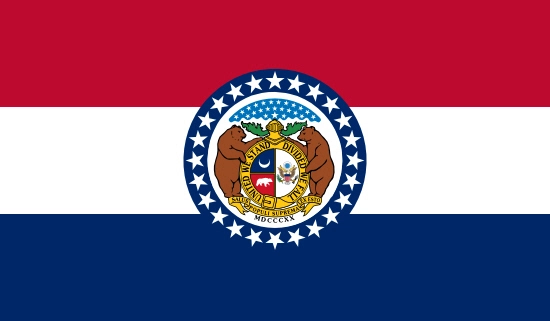
Nearby Labcorp Blood Testing facilities:
- Labcorp Center Distance: 5 m, 2340 E Meyer Blvd Ste 328, Kansas City, Jackson County, MO, 64132
- Labcorp Center Distance: 6 m, 5701 State Avenue, Kansas City, Wyandotte County, KS, 66102
- Labcorp Center Distance: 8 m, 8901 W 74Th St Ste 147, Shawnee Mission, Johnson County, KS, 66204
- Labcorp Center Distance: 10 m, 8101 Parallel Pkwy Ste 400, Kansas City, Wyandotte County, KS, 66112
- Labcorp Center Distance: 11 m, 7800 W 110Th St, Overland Park, Johnson County, KS, 66210
- Labcorp Center Distance: 12 m, 10600 Quivira Suite 340, Overland Park, Johnson County, KS, 66215
- Labcorp Center Distance: 13 m, 19550 E 39Th St Suite 322, Independence, Jackson County, MO, 64057
- Labcorp Center Distance: 14 m, 6815 Hilltop Rd, Shawnee, Johnson County, KS, 66226
- Labcorp Center Distance: 48 m, 212 S Woodbine Rd, Saint Joseph, Buchanan County, MO, 64506
Nearby Quest Blood Testing facilities:
- Quest Center Distance: 4 m, 1628 E 63Rd St, Kansas City, Jackson County, MO, 64110-3502
- Quest Center Distance: 7 m, 5400 N Oak Trfy, Kansas City, Clay County, MO, 64118-4361
- Quest Center Distance: 8 m, 8901 W 74Th St, Shawnee Mission, Johnson County, KS, 66204-2200
- Quest Center Distance: 10 m, 1010 Carondelet Dr, Kansas City, Jackson County, MO, 64114-4823
- Quest Center Distance: 12 m, 12140 Nall Ave, Overland Park, Johnson County, KS, 66209-2503
- Quest Center Distance: 13 m, 10940 Parallel Pkwy, Kansas City, Wyandotte County, KS, 66109-4512
- Quest Center Distance: 17 m, 711 Nw State Route 7, Blue Springs, Jackson County, MO, 64014-2426
- Quest Center Distance: 19 m, 8421 Clint Dr, Belton, Cass County, MO, 64012-5330
- Quest Center Distance: 20 m, 20920 W 151St St, Olathe, Johnson County, KS, 66061-7248
- Quest Center Distance: 36 m, 1130 W 4Th St, Lawrence, Douglas County, KS, 66044-1328
- Quest Center Distance: 49 m, 1213 N Belt Hwy, Saint Joseph, Buchanan County, MO, 64506-2546
- Quest Center Distance: 61 m, 1111 Sw Gage Blvd, Topeka, Shawnee County, KS, 66604-2284
Missouri Hormone Replacement Therapy Services
Bio-Identical Hormone Therapy is a state of the art form of 21st century medical technology that can help you optimize your health and reduce your risk of a wide variety of different medical conditions, from obesity to osteoporosis. The Conscious Evolution Institute is one of the most highly regarded hormone restoration clinics in the United States, and we serve the entire state of Missouri, from St. Louis to Kansas City, from Hannibal to West Plains.
If you are over the age of thirty and feel that your life may be negatively impacted by hormone imbalance, we can provide the comprehensive blood tests necessary to accurately diagnose a variety of afflictions associated with hormone imbalance.
Missouri Human Growth Hormone Therapy
At the Conscious Evolution Institute, our flagship Hormone Restoration Service is HGH Injection Therapy. Most people associate HGH with Puberty or Performance Enhancement, but the hormone is actually vitally important to adult health as well. Our bodies use HGH to stimulate cellular processes which keep us happy and healthy, and if we don't produce enough of it, the body starts to enter a state of decline, as well as the mind.
HGH Deficiency has a number of significant symptoms, including weight gain, depression, fatigue, loss of muscle mass, foggy memory, reduced healing capacity, weakened immune system, and poor sleep. If you feel like your body is losing the ability to keep up with your desire to live a happy and fruitful life, Human Growth Hormone Deficiency may be the root cause. Recombinant HGH Injections restore your body's hormone balance, giving your body the raw materials needed to sustain your life and your health.
Missouri Sermorelin Acetate Therapy
Recombinant Sermorelin Therapy is an alternative to HGH Injections which can also restore optimal HGH Balance. Rather than directly replace the HGH that your body is no longer producing effectively, Sermorelin encourages the pituitary gland to produce youthful levels of Human Growth Hormone.
Both forms of treatment are safe and effective, but some patients may qualify for Sermorelin Injections, even if they don't qualify for HGH Replacement Therapy.
Missouri Low-T Treatments
Testosterone Deficiency is a common and widespread medical condition that affects men all across the nation and the globe. Low-T is not only a condition which affects sexual health, it also diminishes health and wellness in a number of other powerful ways.
Symptoms of Age Related Testosterone Deficiency (or Andropause) include high anxiety, lack of energy, loss of strength and endurance, increased weight gain, insomnia, restless sleep, erectile dysfunction, and lack of libido. Low-T can also increase the risk of a number of health conditions such as atherosclerosis, diabetes, and hypertension, which can all have a devastating affect upon mortality risk. Testosterone Replacement Therapy restores the body's natural sex-hormone balance, encouraging a healthier metabolism and reversing the effects of Andropause
Missouri HCG Weight Loss Therapy
Millions of Americans attempt to lose weight every year, and more people fail than succeed. Obesity is one of the biggest health crises in America today, and being overweight can both tremendously reduce both your quality of life and significantly increase your mortality risk from a variety of chronic health conditions.
For hundreds of thousands of men and women across the United States, HCG Injections have been the answer to their weight loss woes. HCG is a natural hormone produced by the human body which has the ability to increase the success rate of dieting and speed up the weight loss process. HCG Injections vastly reduce the influence of chemical signals which influence hunger while also priming the body to burn stubborn adipose fat over healthy muscle.
Major Cities in Missouri
Kansas City
Kansas City is the largest city in the state of Missouri, and the second largest Metropolitan area behind St. Louis. Kansas City is located along the border of Missouri and Kansas, and the city is split in two by the border. The city is located at the confluence of the Kansas and Missouri Rivers.
Kansas City is often referred to as the Heart of America because of its central location both in regard to national geography and population. Kansas City has a strong Pro Sports presence, with the NFL Kansas City Chiefs and the MLB Kansas City Royals both based in the city.
St. Louis
St. Louis, Missouri is the second largest city in the state, and is the largest metropolitan area. St. Louis is what is referred to as an Independent City, meaning that the city does not belong to a county. The most common nickname of St. Louis is the Gateway to the West, because of its historical importance as a staging ground for American Westward Expansion.
St. Louis is home to three professional sports teams: the NHL St. Louis Blues, the NFL St. Louis Rams, and the MLB St. Louis Cardinals. The most notable landmark in St. Louis is, by far, the Gateway Arch, a 630 foot tall arch structure located along the Mississippi River.
Springfield
Springfield, Missouri is located in the southwestern region of the state, and is the third largest city in Missouri. The city is located on the Ozark Plateau, and is nicknamed the Queen of the Ozarks. Springfield is also home to Bass Pro Shops and Missouri State University.
The economy of Springfield, Missouri revolves around education, retail, manufacturing, healthcare, and tourism, and the largest employers in the area are CoxHealth and the Mercy Health System. Wal-Mart is the third largest employer. O'Reilly Autoparts is based in the city.
Independence
Independence Missouri is a suburb of Kansas City, and is also the fourth largest city in the state. Like St. Louis, Independence was also an important city in Westward Expansion, and garnered the nickname Queen City of the Trails for that reason. Independence was also one of the first homes of the Mormon church.
Columbia
Columbia is most well-known as the home of the Missouri Tigers, the only FBS Football program in the state of Missouri. Columbia is located along the Missouri River, at the edge of the Ozarks. Columbia is a very modern city which is heavily invested in education, healthcare, insurance, and technology, and has an historically limited presence in manufacturing and industry. Finally, Columbia is widely recognized as a progressive city which places a strong emphasis on investigative journalism and liberal politics.
All About Kansas City, Missouri Geographic Area
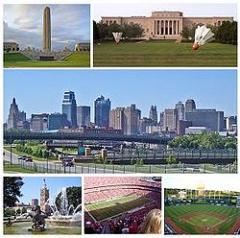

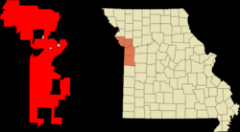
Kansas City, Missouri (informally abbreviated KC)(IATA: MKC) is the largest city in the US state of Missouri and is the anchor city of the Kansas City Metropolitan Area, the second largest metropolitan area in Missouri. It encompasses 316 square miles (820 km2) in parts of Jackson, Clay, Cass, and Platte counties. It is one of two county seats of Jackson County, the other being Independence, which is to the city's east. As of 2011, the population estimate was 463,202 with a metro area of 2.1 million.
Kansas City was founded in 1838 as the Town of Kansas at the confluence of the Missouri and Kansas rivers and was incorporated in its present form in 1850. Situated opposite Kansas City, Kansas, the city was the location of several battles during the Civil War, including the Battle of Westport. The city is well known for its contributions to the musical styles of jazz and blues as well as to cuisine, notably Kansas City-style barbecue. In March 2012, downtown Kansas City was selected as one of America's best downtowns by Forbes magazine for its rich culture in arts, numerous fountains, upscale shopping and various local cuisine ae most notably barbecue.
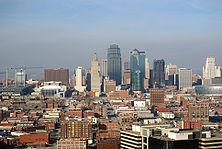
Kansas City, Missouri, is often abbreviated as KC (abbreviations often refer to the metro area). It is officially nicknamed the City of Fountains'. With over 200 fountains, the city claims to have the second most in the world, just behind Rome.It is also called Little Venice. The fountains at Kauffman Stadium, commissioned by original Kansas City Royals owner Ewing Kauffman, are the largest privately-funded fountains in the world. The city also has more boulevards than any city except Paris and has been called "Paris of the Plains." Residents are known as missouri Citians. It is sometimes referred to colloquially as the Heart of America as it is near both the population center of the United States and the geographic center of the 48 contiguous states.
Kansas City, Missouri, was officially incorporated on March 28, 1853. The territory straddling the border between Missouri and Kansas at the confluence of the Kansas and Missouri rivers was considered a good place to build settlements.
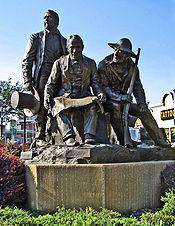
The first documented European visit to Kansas City was Rotienne de Veniard, Sieur de Bourgmont, who was also the first European to explore the lower Missouri River. Criticized for his handling of a Native American attack on Fort Detroit, he had deserted his post as commander of the fort and was avoiding the French authorities. Bourgmont lived with a Native American wife in the Missouri village about 90 miles (140 km) east near Brunswick, Missouri, and illegally traded furs.
In order to clear his name, he wrote "Exact Description of Louisiana, of Its Harbors, Lands and Rivers, and Names of the Indian Tribes That Occupy It, and the Commerce and Advantages to Be Derived Therefrom for the Establishment of a Colony" in 1713 followed in 1714 by "The Route to Be Taken to Ascend the Missouri River." In the documents he describes the junction of the "Grande Riv[iere] des Cansez" and Missouri River, being the first to refer to them by those names. French cartographer Guillaume Delisle used the descriptions to make the first reasonably accurate map of the area.
The Spanish took over the region in the Treaty of Paris (1763), but were not to play a major role in the area other than taxing and licensing all traffic on the Missouri River. The French continued their fur trade on the river under Spanish license. The Chouteau family operated under the Spanish license at St. Louis in the lower Missouri Valley as early as 1765, but it would be 1821 before the Chouteaus reached Kansas City, when Francois Chouteau established Chouteau's Landing.
After the Louisiana Purchase, Lewis and Clark visited the confluence of the Kansas and Missouri rivers, noting it was a good place to build a fort.
In 1831 a group of Mormons from New York settled in an area that would later be part of Kansas City. They built the first school within the current boundaries of the city, but were forced out by mob violence in 1833 and their settlement was left vacant.
In 1833 John McCoy established West Port along the Santa Fe Trail, three miles (5 km) away from the river. Then in 1834, McCoy established Westport Landing on a bend in the Missouri River to serve as a landing point for West Port. Soon after the Kansas Town Company, a group of investors, began to settle the area, taking their name from an English spelling of "Cansez." In 1850 the landing area was incorporated as the Town of Kansas.
By that time, the Town of Kansas, Westport, and nearby Independence, had become critical points in America's westward expansion. Three major trails ae the Santa Fe, California, and Oregon ae all originated in Jackson County.
On February 22, 1853, the City of Kansas was created with a newly elected mayor. It had an area of 0.70 square miles (1.8 km2) and a population of 2,500. The boundary lines at that time extended from the middle of the Missouri River south to what is now Ninth Street, and from Bluff Street on the west to a point between Holmes Road and Charlotte Street on the east.
The Kansas City area was rife with animosity during the period popularly known as Bleeding Kansas, which immediately preceded the Civil War. Already situated just inside a state bitterly divided on the issue of slavery, southern sympathizers in the area immediately recognized the threat posed by neighboring Kansas petitioning to enter the Union under the new doctrine of popular sovereignty. Infuriated by the idea of Kansas becoming a free state, many from the area crossed into Kansas to sway the state towards allowing slavery, at first by ballot box and then by bloodshed.
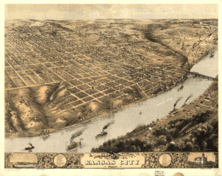
During the Civil War, the City of Kansas and its immediate environs were the focus of intense military activity. Although the First Battle of Independence in August 1862 resulted in a Confederate victory, the Southerners were unable to follow up their win in any significant fashion, as the City of Kansas was occupied by Union troops and proved too heavily fortified for them to assault. The Second Battle of Independence, part of Sterling Price's Missouri expedition of 1864, also resulted in a Confederate triumph. Once again the Southern victory proved hollow, as Price was decisively defeated in the pivotal Battle of Westport the next day, effectively ending Confederate efforts to occupy the city.
Moreover, General Thomas Ewing, in response to a successful raid on nearby Lawrence, Kansas, led by William Quantrill, issued General Order No. 11, forcing the eviction of residents in four western Missouri counties aeincluding Jackson aeexcept those living in the city and nearby communities and those whose allegiance to the Union was certified by Ewing.
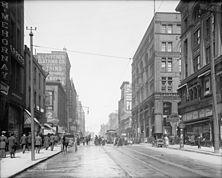
After the Civil War, the City of Kansas grew rapidly. The selection of the city over Leavenworth, Kansas, for the Hannibal & St. Joseph Railroad bridge over the Missouri River brought about significant growth. The population exploded after 1869, when the Hannibal Bridge, designed by Octave Chanute, opened. The boom prompted a name change to Kansas City in 1889 and the city limits to extend south and east. Westport became part of Kansas City on December 2, 1897. In 1900, Kansas City was the 22nd largest city in the country, with 163,752 residents.
Kansas City, guided by architect George Kessler, became a forefront example of the City Beautiful movement, developing a network of boulevards and parks around the city.
The relocation of Union Station to its current location in 1914 and the opening of the Liberty Memorial in 1923 gave the city two of its most identifiable landmarks. Robert A. Long, president of the Liberty Memorial Association, was a driving force in the funding for construction. Long was a longtime resident and wealthy businessman having built the R.A. Long Building for the Long-Bell Lumber Company, his home, Corinthian Hall now the Kansas City Museum, and Longview Farm, he was known and respected.
Further spurring Kansas City's growth was the opening of the innovative Country Club Plaza development by J.C. Nichols in 1925 as part of his Country Club District plan.
At the turn of the 19th to 20th century, political machines attempted to gain clout in the city, with the one led by Tom Pendergast emerging as the dominant machine by 1925. Several important buildings and structures were built during this time, including the Kansas City City Hall and the Jackson County Courthouse aeboth added new skyscrapers to the city's growing skyline. The machine fell in 1939 when Pendergast, riddled with health problems, pleaded guilty to tax evasion.
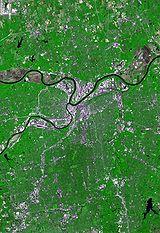
Kansas City's suburban development originally began with the implementation of streetcars in the early decades of the 20th century. The city's first suburbs were in the neighborhoods of Pendleton Heights and Quality Hill. After World War II, many relatively affluent residents left for suburbs like Johnson County, Kansas and eastern Jackson County, Missouri. Many also went north of the Missouri River, where Kansas City had incorporated areas between the 1940s to 1970s.
In 1950, blacks represented 12.2% of Kansas City's population. The sprawling characteristics of the city and it environs today mainly took shape after the race riots of the 1960s in Kansas City. The assassination of Martin Luther King Jr. was a catalyst for the 1968 Kansas City riot. At this time, slums were also beginning to form in the inner city, and those who could afford to leave, left for the suburbs and outer edges of the city. The post aeWorld War II idea of suburbs and the "American Dream" also contributed to the sprawl of the area. As the city's population continued to grow, the inner city also continued to decline. The city's most populous ethnic group, non-Hispanic white, has declined from 89.5% in 1930 to 54.9% in 2010.
In 1940, the city had about 400,000 residents; by 2000, the same area was home to only about 180,000. From 1940 to 1960, the city more than doubled its physical size, while increasing its population by only about 75,000. By 1970, the city had a total area of approximately 316 square miles (820 km2), more than five times its size in 1940.
The Hyatt Regency walkway collapse was a major disaster that occurred on July 17, 1981 killing 114 people and injuring more than 200 others during a tea dance. At the time it was the deadliest structural collapse in U.S. history.
According to the United States Census Bureau, the city has a total area of 316.0 square miles (818 km2). 311.5 square miles (807 km2) of it is land and 4.5 square miles (12 km2) of it (1.41%) is water. Much of urban Kansas City sits atop bluffs overlooking the rivers and river bottoms areas. Kansas City proper is bowl-shaped and is surrounded to the north and south by limestone and bedrock cliffs that were carved by glaciers. Kansas City is situated at the junction between the Dakota and Minnesota ice lobes during the maximum late Independence glaciation of the Pleistocene epoch. The Kansas and Missouri rivers cut wide valleys into the terrain when the glaciers melted and drained. A partially filled spillway valley crosses the central portion of Kansas City, Missouri. This valley is an eastward continuation of Turkey Creek valley. It lies more or less at the geographic centre of the United States of America.
Kansas City lies in the Midwestern United States, as well as near the geographic center of the country, at the confluence of the second largest river in the country, the Missouri River, and the Kansas River (also known as the Kaw River). The city lies in the southern margin of the humid continental (Koppen Dfa) climatic zones, with four distinct seasons, and moderate precipitation. Most of the Greater Kansas City metropolitan area sees a fairly mild climate for various periods in each season. However, there is also significant potential for extremes of hot and cold swings in temperature all year long. The warmest month of the year is July, with a 24-hour average temperature of 81 °F (27.2 °C). The summer months are warm but can get hot and moderately humid, with moist air riding up from the Gulf of Mexico, and high temperatures surpass 100 °F (38 °C) on 4 days of the year, and 90 °F (32 °C) on nearly 40 days. Fall is characterized by mild days and cool nights. The coldest month of the year is January, with an average temperature of 30.5 °F ( na0.8 °C). Winters are generally dry and range from cool to moderately cold, with a mere 2.6 nights with a low below 0 °F ( na18 °C). The record high temperature here is 112 °F (44 °C), set on July 13, 1954, and the record low is na19 °F ( na28 °C), set on December 22, 1989. Annual average snowfall is a moderate 19.9 inches (51 cm). The first freezing temperature tends to occur around October 31, with the last around April 4, according to weather.com the average first snowfall occurs on November 27th, and the first 1 inch (2.5 cm) or greater snowfall occurring around early December. Precipitation, both in frequency and total accumulation, shows a marked uptick in late spring and summer.
Kansas City is situated in "Tornado Alley," a broad region where cold air from the Rocky Mountains in Canada collide with warm air from the Gulf of Mexico, leading to the formation of powerful storms especially during the spring. A few areas of the Kansas City Metropolitan Area have had some severe outbreaks of tornadoes at different points in the past, including the Ruskin Heights tornado in 1957, and the May 2003 tornado outbreak sequence. The region can also fall victim to the sporadic ice storm during the winter months, such as the 2002 ice storm during which hundreds of thousands lost power for days and (in some cases) weeks. Kansas City and its outlying areas are also subject to flooding, including the Great Flood of 1993 and the Great Flood of 1951.

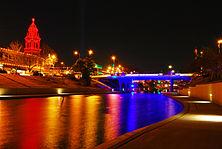
Kansas City, Missouri, is organized into a system of more than 240 neighborhoods, some with histories as independent cities or the sites of major events. Downtown, the center of the city, is currently undergoing major redevelopment with new condos, apartments, offices and The Power & Light District (shopping/entertainment development) complete with bars, restaurants, a grocery store with a roof-top pool club called The Jones, a performing arts center, and The Sprint Center. All these things have made downtown/midtown an attractive residential option, more so than in the past. Near Downtown, the urban core of the city has a variety of neighborhoods, including historic Westport, Ivanhoe, Hyde Park, Squire Park, the Crossroads Arts District, 18th and Vine Historic District, Pendleton Heights, Quality Hill, the West Bottoms, and the River Market. Two other "near" downtown neighborhoods that are very popular and have unique appeal are the Country Club Plaza (or simply the "Plaza"), south Plaza and nearby Brookside.
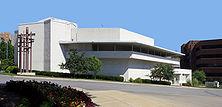
The city's skyline is what one might envision for a major Midwest city, with some notable exceptions. The Nelson-Atkins Museum opened the stunning Euro-Style Bloch addition in 2007. The towering Power and Light Building is influenced by the Art Deco style and contains a glowing sky beacon. The new world headquarters of H&R Block is a 20 story all glass oval which is bathed from top to bottom in a soft green light. The four Industrial art works atop the support towers of the Kansas City Convention Center (Bartle Hall) were once the subject of ridicule but now define the night skyline near the new Sprint Center along with One Kansas City Place (the tallest office tower structure in Missouri), the KCTV-Tower with its hundreds of lit bulbs (the tallest freestanding structure in Missouri), and the Liberty Memorial, a WWI memorial and museum, which flaunts simulated flames and smoke billowing into the night skyline. Kansas City is home to significant national and international architecture firms including ACI Boland, BNIM, 360 Architecture, Ellerbe Becket, HNTB, Populous. Frank Lloyd Wright designed two private residences and the Community Christian Church.
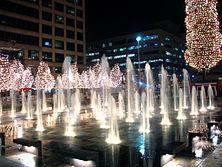
Kansas City contains a collection of over 200 working fountains. Some of the most notable are on the Country Club Plaza. From French inspired traditional to modern, these fountains offer visitors to the city an unexpected bonus. Among the most notable: the Black Marble H&R Block fountain in front of Union Station with its synchronized water jets shooting high into the air, the Nichols Bronze Horses at the corner of Main and JC Nichols Parkway at the entrance to the Plaza Shopping District and the unique "family friendly" walk through fountain at Hallmark Cards World Headquarters in Crown Center.
Since its inception in 1857, the City Market has been one of the largest and most enduring public farmers' markets in the midwest, linking growers and small businesses to the Kansas City community. In addition, more than 30 full-time merchants are open year-round and offer specialty foods, fresh meats and seafood, restaurants and cafes, floral, home accessories and much more.
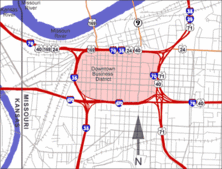
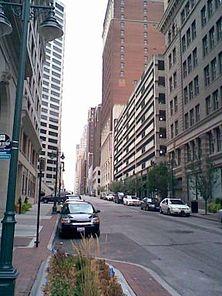
Downtown Kansas City is an area of 2.9 square miles (7.5 km2) bounded by the Missouri River to the north, 31st Street to the south, Troost Avenue to the East, and State Line road to the West. Areas near Downtown Kansas City include the 39th Street District is known as Restaurant Row and features one of Kansas City's largest selections of independently owned restaurants and boutique shops. It is a center of literary and visual arts and bohemian culture. Crown Center is the headquarters of Hallmark Cards and a major downtown shopping and entertainment complex. It is connected to Union Station by a series of covered walkways. The Country Club Plaza, or simply "the Plaza", is an upscale, outdoor shopping and entertainment district. It was the first suburban shopping district in the United States, designed to accommodate shoppers arriving by automobile, and is surrounded by apartments and condominiums, including a number of high rise buildings. The associated Country Club District to the south includes the Sunset Hill and Brookside neighborhoods, and is traversed by Ward Parkway, a landscaped boulevard known for its statuary, fountains and large, historic homes. Kansas City's Union Station is home to Science City, restaurants, shopping, theaters, and the city's Amtrak facility.
After years of neglect and seas of parking lots, Downtown Kansas City currently is undergoing a period of change. Many residential properties recently have been or currently are under redevelopment. The Power & Light District, a new, nine-block entertainment district comprising numerous restaurants, bars, and retail shops, was developed by the Cordish Company of Baltimore, Maryland, Its first tenant opened on November 9, 2007. It is anchored by the Sprint Center, a 19,000 seat complex that has become a top draw for sports and musical entertainment. Elton John was the first performer to play at the Sprint Center.
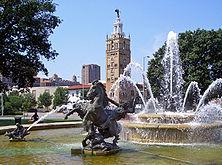
Kansas City has 132 miles (212 km) of spacious boulevards and parkways, 214 urban parks, 49 ornamental fountains, 152 ball diamonds, 10 community centers, 105 tennis courts, five golf courses, five museums and attractions, 30 pools, and 47 park shelters, all overseen by the city's Parks and Recreation department.
The parks and boulevard system winds its way through the city. Much of the system, designed by George E. Kessler, was constructed from 1893 to 1915. Cliff Drive, in Kessler Park on the North Bluffs, is a designated State Scenic Byway. It extends 4.27 miles (6.87 km) from The Paseo and Independence Avenue through Indian Mound on Gladstone Boulevard at Belmont Boulevard with many historical points and architectural landmarks. Ward Parkway, on the west side of the city near State Line Road, is lined by many of the city's most handsome homes. The Paseo is a major north aesouth parkway that runs 19 miles (31 km) through the center of the city beginning at Cliff Drive. It was modeled on the Paseo de la Reforma, a fashionable Mexico City boulevard.
Swope Park is one of the nation's largest city parks, comprising 1,805 acres (2.82 sq. mi.), more than twice as big as New York's Central Park. It features a full-fledged zoo, a woodland nature and wildlife rescue center, two golf courses, two lakes, an amphitheatre, day-camp area, and numerous picnic grounds. Hodge Park, in the Northland, covers 1,029 acres (1.61 sq. mi.). This park includes the 80-acre (320,000 m2) Shoal Creek Living History Museum, a village of more than 20 historical buildings dating from 1807 to 1885. Riverfront Park, 955 acres (3.86 km2) on the banks of the Missouri River on the north edge of downtown, holds annual Fourth of July celebrations and other festivals during the year.
A program went underway to replace many of the fast-growing sweetgum trees with hardwood varieties.
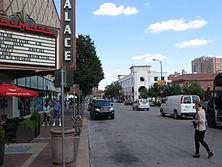
The Kansas City Repertory Theatre, the metropolitan area's top professional theatre company and the Starlight Theatre, 8,105-seat outdoor theatre designed by Edward Delk are a popular theatre company and theatre respectively. The Kansas City Symphony was founded by R. Crosby Kemper Jr. in 1982 to supersede the Kansas City Philharmonic, which was founded 1933. The symphony currently is located at the new Kauffman Center for the Performing Arts. The current music director and lead conductor of the symphony is Michael Stern. Lyric Opera of Kansas City, founded in 1970, offers one American contemporary opera production during its annual season consisting of either four or five productions. The Lyric Opera also is also located at the Kauffman Center for the Performing Arts. The Civic Opera Theater of Kansas City, performs at the Folly Theater in downtown, and the UMKC Performing Arts Center. Every summer form mid-June to early July, The Heart of America Shakespeare Festival has a production at Southmoreland Park near the Nelson-Atkins Museum. Marilyn Strauss founded the festival in 1993 and it has gone on ever since.
The Kansas City Ballet, founded in 1957 by Tatiana Dokoudovska, is a ballet troupe comprising 25 professional dancers and apprentices. Between 1986 and 2000, it was combined with Dance St. Louis to form the State Ballet of Missouri, although it remained located in Kansas City. From 1980 to 1995, the Ballet was run by dancer and choreographer Todd Bolender. Today, the Ballet offers an annual repertory split into three seasons which ranges from classical to contemporary ballets. The Ballet also is located Kauffman Center. Kansas City is also home to The Kansas City Chorale, a professional 24-voice chorus conducted by Charles Bruffy. They perform an annual concert series in Kansas City and a concert in Phoenix each year with their sister choir, the Phoenix Chorale. The Chorale has achieved international renown with 9 recordings,(3 with the Phoenix Chorale).
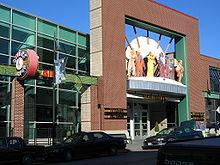
Kansas City jazz in the 1930s marked the transition from big bands to the bebop influence of the 1940s. The 1979 documentary The Last of the Blue Devils portrays this era in interviews and performances by jazz notables from KC.
In the 1970s, Kansas City attempted to resurrect the glory of the jazz era in a sanitized family friendly atmosphere. In the 1970s, an effort to open jazz clubs in the River Quay area of City Market along the Missouri ended in a gangland war in which three of the new clubs were blown up in what ultimately resulted in the removal of Kansas City mob influence in the Las Vegas casinos. The annual "Kansas City Blues and Jazz Festival", which attracts top jazz stars nationwide and large out-of-town audiences, has been rated Kansas City's "best festival." by pitch.com
Live music venues can be found throughout the city, with the highest concentration in the Westport entertainment district centered on Broadway and Westport Road near the Country Club Plaza, as well as the 18th & Vine area (jazz music). A variety of music genres can be heard and have originated in Kansas City metro area, including: Rock groups Puddle of Mudd, Isaac James, Shooting Star, The Get Up Kids, Shiner, Flee The Seen, The Life and Times, Reggie and the Full Effect, Coalesce, The Casket Lottery, The Gadjits, The Rainmakers, Vedera, The Elders, Blackpool Lights and The Republic Tigers and Rappers Tech N9ne, Krizz Kaliko, Kutt Calhoun, Skatterman & Snug Brim, Mac Lethal, and Sole.
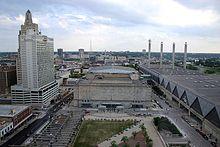
There is a large community of Irish-Americans in Kansas City which numbers around 250,000. The Irish community includes a large number of bands, multiple newspapers, the numerous Irish stores, including Browne's Irish Market, and the Irish Museum and Cultural Center is the new center of the community. The first book that detailed the history of the Irish in Kansas City was Missouri Irish, Irish Settlers on the American Frontier, published in 1984.
Missouri voters approved riverboat casino gaming on the Missouri and Mississippi Rivers by referendum with a 63% majority on November 3, 1992. The first casino facility in the state opened in September 1994 in North Kansas City by Harrah's Entertainment (now Caesar's Entertainment). The combined revenues for the four casinos successfully operating in Kansas City exceeded $153 million per month in May 2008. The four casinos are Ameristar Kansas City, Argosy Kansas City, Harrah's North Kansas City, Isle of Capri Kansas City. A fifth area casino, the 7th Street Casino, opened in Kansas City, KS in 2008. The casino's are interestingly growing as Hollywood casino opened in February 2012 in Kansas City, Kansas. Hollywood casino is also built on land as the "riverboat" casinos are no longer such.
Kansas City is most famous for its steak and barbecue.

During the heyday of the Kansas City Stockyards, the city was known for its Kansas City steaks or Kansas City strip steaks. The most famous of the steakhouses is the Golden Ox in the Kansas City Live Stock Exchange in the stockyards in the West Bottoms. The stockyards, which were second only to those of Chicago in size, never recovered from the Great Flood of 1951 and eventually closed. The famed Kansas City Strip cut of steak is largely identical to the New York Strip cut, and is sometimes referred to just as a strip steak. Along with Texas, Memphis & North and South Carolina, Kansas City is a "world capital of barbecue." There are more than 90 barbecue restaurants in the metropolitan area and the American Royal each fall hosts what it claims is the world's biggest barbecue contest.
The classic Kansas City-style barbecue was an inner-city phenomenon that evolved from the pit of Henry Perry from the Memphis, Tennessee, area in the early 20th century and blossomed in the 18th and Vine neighborhood. Arthur Bryant's was to take over the Perry restaurant and added molasses to sweeten the recipe. In 1946 Gates and Sons Bar-B-Q was opened by one of Perry's cooks. The Gates recipe added even more molasses. Although Bryant's and Gates are the two definitive Kansas City barbecue restaurants they have just recently begun expanding outside of the Greater Kansas City Area. Fiorella's Jack Stack Barbecue is well regarded by many both locally and nationally. In 1977 Rich Davis, a psychiatrist, test-marketed his own concoction called K.C. Soul Style Barbecue Sauce. He renamed it KC Masterpiece and in 1986 he sold the sauce to the Kingsford division of Clorox. Davis retained rights to operate restaurants using the name and sauce.
Roman Catholic
Kansas City's Cathedral of the Immaculate Conception is the cathedral seat of the Roman Catholic Diocese of Kansas City and St. Joseph; The Cathedral of St. Peter in nearby Kansas City, Kansas is the seat of the Catholic Archdiocese of Kansas City in Kansas.
Eastern and Oriental Orthodox
The Kansas City area is home to nine Eastern Orthodox churches, including three Serbian Orthodox churches, two Greek Orthodox parishes, two parishes of the Orthodox Church in America, an Antiochian Orthodox church, and a mission of the Russian Orthodox Church Outside Russia.
The area is home to two Orthodox mission groups, one local and one national. Reconciliation Services is a local mission group aimed at providing assistance and therapeutic services to those in need. It is also the national headquarters of FOCUS North America, a missions group aimed at helping other national Orthodox charities and providing assistance to those in need.
Kansas City is also home to one Oriental Orthodox church, a parish of the Coptic Church.
Protestant bodies
The Kansas City metropolitan area is the seat of the Unity Church, a Christian denomination claiming approximately two million members. The church's headquarters is located in Unity Village, a self-contained, incorporated municipality lying east of the city near Lee's Summit. The Church of the Nazarene, another Christian denomination claiming two million members worldwide, is headquartered in Lenexa, where it moved in 2008 from its longtime headquarters on the The Paseo in Kansas City itself. United Methodism's Church of the Resurrection is the largest church in the metro area, consisting of 15,000+ members and is the largest United Methodist Church in the United States. The Episcopal Diocese of West Missouri has its headquarters at Grace and Holy Trinity Cathedral, downtown.
Latter Day Saint groups

Several Latter Day Saint organizations make their headquarters in Independence, just east of the city. The largest of these is the Community of Christ, with a worldwide membership of approximately 250,000. Others include the Church of Christ (Temple Lot), the Church of Christ (Fettingite), the Church of Christ with the Elijah Message, the Church of Christ (Restored), the Restoration Church of Jesus Christ, and the Church of Jesus Christ (Cutlerite). Movement founder Joseph Smith, Jr. told his earliest followers that the Garden of Eden had been located in Jackson County, and that the New Jerusalem where Jesus will come in the Second Coming would be built in Independence. Some early Latter Day Saints settled west of Independence, inside what are now the boundaries of Kansas City itself. The Latter Day Saints were violently driven from the area in late 1833, after protracted conflict with local settlers, but returned in the late 1860s to a much better welcome. In May 2012 The Church of Jesus Christ of Latter-day Saints, the largest LDS denomination, dedicated a temple in the Shoal Creek area of Kansas City North.
Non-Christian
Kansas City is home to a large and vibrant Jewish community, with several synagogues in the city and adjacent communities. Muslims are served by three mosques within the city limits, the largest of which is the Islamic Society of Greater Kansas City, plus additional mosques in nearby towns. Temple Buddhist Center, the Rime Buddhist Center and other Buddhist facilities serve Buddhists in the city, while the Hindu Cultural Center and Vedanta Society of Kansas City serve Kansas City's Hindu population. Kansas City is even home to at least one congregation of Neo-Pagans in the form of Gaia Community.
Nonreligious
Kansas City has many nonreligious, atheist, humanist, Naturalist and agnostic groups., such as the Kansas City Atheist Coalition.
Kansas City ranks below US average for religious identity. Over 53% have no religious identity.

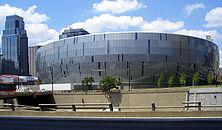
Professional sports teams in Kansas City include the Kansas City Chiefs in football, the Kansas City Royals in baseball, and Sporting Kansas City in soccer.
In college athletics, Kansas City has been the home of the Big 12 College Basketball Tournaments. Men's basketball has been played at Sprint Center since March 2008, and women's basketball is played at Municipal Auditorium. Arenas in Dallas and Oklahoma City have also historically hosted the tournament. Arrowhead Stadium serves as the venue for various intercollegiate football games. It has hosted the Big 12 Championship Game five times. On the last weekend in October, the Fall Classic rivalry game between Northwest Missouri State University and Pittsburg State University takes place here. The Bearcats of Northwest and Gorillas of Pitt State are frequently ranked one-two in the MIAA conference. In 2005, other games at Arrowhead included Arkansas State playing host to Missouri, and Kansas hosting Oklahoma.
The Chiefs started play in 1960 as the Dallas Texans and started playing in KC in 1963. The Royals started in 1969 and are the only major league KC team that has neither moved nor changed its name. The Kansas City Wizards was a charter member of MLS in 1996 and became the Wizards from 1997 onwards. In 2011, the team was renamed Sporting Kansas City and moved into their new stadium in Kansas City, Kansas.
Kansas City used to have an NBA team, which had originated in 1945 in Rochester, New York (as the Rochester Royals), before becoming the Cincinnati Royals. The team was called the Kansas City-Omaha Kings from 1972 to 1975 because it played home games in both cities. In 1975, the team played exclusively in Kansas City, and was known as the Kansas City Kings. The Kings played there until 1985, when the franchise moved to California and became the Sacramento Kings.
In 1974, the NHL continued its expansion period by adding teams in Kansas City and Washington, D.C. Although they were better than their expansion cousins, who won only eight games in their inaugural season, the Kansas City Scouts began to suffer from an economic downturn in the Midwest. For their second season, the Scouts sold just 2,000 of 8,000 season tickets and were almost $1 million in debt. Due to their various on and off ice disappointments, the franchise moved to Denver before settling on the east coast as the New Jersey Devils.
The Scouts and Kings were not the only nomadic franchises to spend time in Kansas City. The Athletics baseball franchise played in the city of fountains from 1955 to 1967, after moving from Philadelphia and before moving to Oakland. Major League Baseball returned to the city in 1969 with the Royals, who have proven stable and became the first American League expansion team to reach the playoffs, in 1976, the World Series, in 1980 and to win the World Series, in 1985 against the state-rival St. Louis Cardinals in the "Show-Me Series."
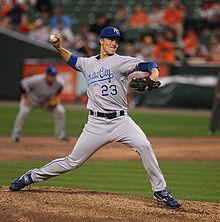

The Kansas City Star is the area's primary newspaper. William Rockhill Nelson and his partner, Samuel Morss, first published the evening paper on September 18, 1880. The Star competed heavily with the morning Times before acquiring it in 1901. The "Times" name was discontinued in March 1990, when the morning paper was renamed the "Star."
Weekly newspapers include The Call, which is focused toward Kansas City's African-American community, together with the Kansas City Business Journal, The Pitch, The Ink, and the bilingual paper Dos Mundos.
The city is served by two major faith-oriented newspapers: The Kansas City Metro Voice, serving the Christian community, and the Kansas City Jewish Chronicle, serving the Jewish community. It also the headquarters of the National Catholic Reporter, an independent Catholic newspaper.
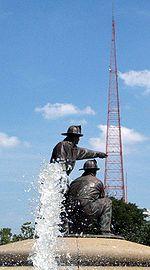
The Kansas City media market (ranked 32nd by Arbitron and 31st by Nielsen) includes 10 television channels, along with 30 FM and 21 am radio stations. Kansas City broadcasting jobs have been a stepping stone for many nationally recognized television and radio personalities, including Walter Cronkite, Rush Limbaugh, and Mancow Muller.
Kansas City has also been a locale for Hollywood productions and television programming. Also, between 1931 and 1982, Kansas City was home to the Calvin Company, a large movie production company that specialized in the making of promotional and sales training short films and commercials for large corporations, as well as educational movies for schools and training films for government. Calvin was also an important venue for the Kansas City arts, serving as training ground for many local filmmakers who went on to successful Hollywood careers, and also employing many local actors, most of whom earned their main income in other fields, such as radio and television announcing. Kansas City native Robert Altman got his start directing movies at the Calvin Company, and this experience led him to making his first feature film, The Delinquents, in Kansas City using many local thespians.
The 1983 television movie The Day After was filmed in Kansas City and Lawrence, Kansas. The 1990s film Truman starring Gary Sinise was also filmed in various parts of the city. Other films shot in or around Kansas City include Article 99, Mr. & Mrs. Bridge, Kansas City, Paper Moon, In Cold Blood, Ninth Street, and Sometimes They Come Back (in and around nearby Liberty, Missouri). More recently, a scene in the controversial film Bruno was filmed in the historic Hotel Phillips downtown.
Kansas City is also home to a vibrant and active independent film community. The Independent Filmmaker's Coalition of Kansas City is an organization dedicated to expanding and improving independent filmmaking in Kansas City.
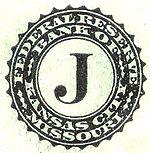
Three international law firms, Lathrop & Gage, Stinson Morrisson & Hecker, and Shook, Hardy & Bacon are based in the City.
Numerous agriculture companies operate out of the city . Dairy Farmers of America, the largest Dairy Co-op in the United States is located here. Kansas City Board of Trade is the principal trading Exchange for hard red winter wheat ae the principal ingredient of bread.
Kansas City, Missouri is the headquarters of:
Kansas City is one of ten regional office cities for the United States Government. The U.S. Government is the largest employer in the Kansas City metro area, with more than 146 federal agencies maintaining a presence. The Internal Revenue Service maintains a large service center in Kansas City that is nearly 1,400,000 square feet (130,000 m2). The IRS facility is one of only two facilities in the nation to process paper returns. The IRS has approximately 2,700 full-time employees in Kansas City and upwards of 4,000 employees during peak tax season with the addition of temporary employees. The General Services Administration has more than 800 employees in Kansas City, with most located at the Bannister Federal Complex in South Kansas City. The Bannister Complex is also home to the Kansas City Plant, which is a National Nuclear Security Administration facility operated by Honeywell. Honeywell employs nearly 2,700 at the Kansas City Plant, which produces and assembles 85 percent of the non-nuclear components of the United States nuclear bomb arsenal. The Social Security Administration has more than 1,700 employees in the Kansas City area, with more than 1,200 located at its Mid-America Program Service Center (MAMPSC) in downtown Kansas City.
The National Association of Intercollegiate Athletics and The National Association of Basketball Coaches are based in Kansas City.
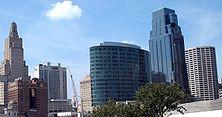
The business community is serviced by two major business magazines, the Kansas City Business Journal (published weekly) and Ingram's Magazine (published monthly), as well as numerous other smaller publications, including a local society journal, the Independent (published weekly). Kansas City is literally "on the money." Bills issued by the Federal Reserve Bank of Kansas City are marked the letter "J" and/or number "10." The single dollar bills have Kansas City's name on them. The Kansas City Federal Reserve built a new bank building that opened in 2008 and relocated near Union Station. Missouri is the only state to have two of the 12 Federal Reserve Bank headquarters (St. Louis also has a headquarters). Kansas City's effort to get the bank was helped by former Kansas City mayor James A. Reed who as senator broke a tie to get the Federal Reserve Act passed.
One of the largest drug manufacturing plants in the United States is the Sanofi-Aventis plant located in south Kansas City on the campus developed by Ewing Kauffman's Marion Laboratories. Of late, it has been developing some academic and economic institutions related to animal health sciences, an effort most recently bolstered by the selection of Manhattan, Kansas, at one end of the Kansas City Animal Health Corridor, as the site for the National Bio and Agro-Defense Facility, which is tasked, among other things, to research animal-related diseases.
Ford Motor Company operates a large manufacturing facility just outside of Kansas City in Claycomo at the Ford Kansas City Assembly Plant, which currently builds the Ford Escape, Mazda Tribute, Ford F-150, and Mercury Mariner. The General Motors Fairfax Assembly Plant s located in adjacent Kansas City, Kansas. Smith Electric Vehicles builds electric vehicles in the former TWA/American Airlines overhaul facility at Kansas City International Airport.
The national headquarters for the Veterans of Foreign Wars is headquartered just south of Downtown Kansas City.
With a Gross Metropolitan Product of $41.68 billion in 2004, Kansas City's (Missouri side only) economy makes up 20.5% of the Gross State Product of Missouri.
According to the 2010 census, the racial composition of Kansas City was as follows:
The Hispanic population of Kansas City, which is heavily Mexican, is most concentrated in the northeast part of the city. The Asian population, mainly Vietnamese, resides within the Columbus Park neighborhood in the Greater Downtown area, a historical Italian American neighborhood, and in River Forest, in northern Kansas City.
The Historic Kansas City boundary which is roughly 58 sq Miles, and has a population Density of about 5,000 people per sq mile. It runs from The Missouri River to the North, 79th st. to the South, the Blue river to the East, and State Line Rd. to the West. During the 1960s and 1970s Kansas City Annexed large amounts of Land which is largely undeveloped to this day.
Kansas City is home to the largest municipal government in the state of Missouri. The city has a city manager form of government, however the role of city manager has diminished over the years following excesses during the days of Tom Pendergast. The mayor is the head of the Kansas City City Council, which has 12 members (one member for each district, plus one at large member per district), and the mayor himself is the presiding member. Kansas City holds city elections on odd numbered years (every four years unless there is a special reason). The last major city-wide election was in May 2011, meaning the next one will be held in May 2015. Following the 2007 election, the city council had a female majority for the first time in the city's history.
Tom Pendergast was the most infamous leader of the party machine. The most nationally prominent Democrat associated with Pendergast's machine was Harry S Truman, who became a Senator, Vice President of the United States and then President of the United States from 1945 to 1953. Kansas City is the seat of the United States District Court for the Western District of Missouri, one of two federal district courts in Missouri (the other, the Eastern District, is in St. Louis). It also is the seat of the Western District of the Missouri Court of Appeals, one of three districts of that court (the Eastern District is in St. Louis and the Southern District is in Springfield).
There are 230,897 registered voters.
Kansas City has hosted the 1900 Democratic National Convention, the 1928 Republican National Convention, which nominated Herbert Hoover from Iowa for President, and the memorable 1976 Republican National Convention, which nominated Kansas U.S. Senator Bob Dole for Vice President. The urban core of Kansas City consistently votes Democratic in Presidential elections, however on the state and local level Republicans often find some success, especially in the Northland and other parts of Kansas City that are predominantly suburban.
Kansas City is represented by two members of the United States House of Representatives:
The United States Postal Service operates post offices in Kansas City. The Kansas City Main Post Office is located at 300 West Pershing Road.
Some of the earliest violence in Kansas City erupted during the American Civil War. Shortly after the city's incorporation in 1850, the period which has become known as Bleeding Kansas erupted, affecting border ruffians and Jayhawkers, who both lived in the city. During the war, Union troops burned all occupied dwellings in Jackson County south of Brush Creek and east of Blue Creek to Independence in an attempt to halt raids into Kansas. After the war, the Kansas City Times turned outlaw Jesse James into a folk hero in its coverage. James was born in the Kansas City metro area at Kearney, Missouri, and notoriously robbed the Kansas City Fairgrounds at 12th Street and Campbell Avenue.
In the early 20th century under Democratic political "Boss" Tom Pendergast, Kansas City became the country's "most wide open town". While this would give rise to Kansas City Jazz, it also led to the rise of the Kansas City mob (initially under Johnny Lazia), as well as the arrival of organized crime. In the 1970s, the Kansas City mob was involved in a gangland war over control of the River Quay entertainment district, in which three buildings were bombed and several gangsters were killed. Police investigations into the mob took hold after boss Nick Civella was recorded discussing gambling bets on Super Bowl IV (where the Kansas City Chiefs defeated the Minnesota Vikings). The war and investigation would lead to the end of mob control of the Stardust Casino, which was the basis for the film Casino (although the Kansas City connections are minimized in the movie).
As of October 30, 2006, Kansas City ranks 21st on the Federal Bureau of Investigation's annual survey of crime rates for cities with populations over 400,000. Kansas City ranked sixth in the rate of murders in that same study. The entire Kansas City metropolitan area has the fourth worst violent crime rate among cities with more than 100,000, with a rate of 614.7 violent crimes per 100,000 residents. In 2010 Forbes.com ranked Kansas City as the third most dangerous city in the country. On the other hand, many of the surrounding cities in the Kansas City Metropolitan Area reflect the opposite in crime statistics.
Much of the city's murders and violent crimes occur in the city's inner core. In the 2000s (decade), Crime and Homicides spiked up due to organized crime or the gang activity in the inner city. However, attempts at revitalizing the downtown area have been more successful. Other parts of the urban core with higher poverty levels remain places in which crime remains largely unabated. According to an analysis by The Kansas City Star and the University of Missouri-Kansas City appearing in a December 22, 2007 story, downtown has experienced the largest drop in crime of any neighborhood in the city during the current decade.
In 2009, Zip Code 64130, which straddles Brush Creek east of the Country Club Plaza was reported to account for 20 percent of Kansas Citians in prison for murder or voluntary manslaughter (101 killers).
First, it was at the confluence of the Missouri River and Kansas River and the launching pointing for travelers on the Santa Fe, Oregon, and California trails. Then with the construction of the Hannibal Bridge across the Missouri River it became the central location for 11 trunk railroads. More rail traffic in terms of tonnage still passes through the city than any other city in the country. TWA located its headquarters in the city and had ambitious plans to turn the city into an air hub for the world.
Missouri and Kansas were the first states to start building interstates with Interstate 70. Interstate 435, which encircles the entire city, is the second longest beltway in the nation. Today, Kansas City and its metropolitan area has more miles of limited access highway lanes per capita than any other large metro area in the United States, over 27% more than second-place Dallas/Fort Worth Metroplex, over 50% more than the average American metro area and nearly 75% more than the metropolitan area with the least: Las Vegas. The Sierra Club in particular blames the extensive freeway network for excessive sprawl and the decline of central Kansas City. On the other hand, the relatively uncongested freeway network contributes significantly to Kansas City's position as one of America's largest logistics hubs.
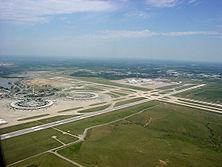
Kansas City International Airport was built to the specifications of TWA to make a world hub for the supersonic transport and Boeing 747. Its passenger friendly design in which its gates were 100 feet (30 m) from the street has, since the September 11, 2001 attacks, required a costly overhaul to retrofit it to incorporate elements of a more conventional security system. Recent proposals have suggested replacing the three terminals with a new single terminal situated south of the existing runways, thus allowing the airport to operate during construction and to shave miles off the travel distance from downtown and the southern suburbs. Charles B. Wheeler Downtown Airport was the original headquarters of Trans World Airlines and houses the Airline History Museum. It is still used for general aviation and airshows.
Like most American cities, Kansas City's mass transit system was originally rail-based. An electric trolley network ran through the city until 1957. The rapid sprawl in the following years led this privately run system to be shut down. The Kansas City Area Transportation Authority (KCATA) was formed with the signing of a Bi-State compact created by the Missouri and Kansas legislatures on December 28, 1965. The compact gives the KCATA responsibility for planning, construction, owning and operating passenger transportation systems and facilities within the seven-county Kansas City metropolitan area. These include the counties of Cass, Clay, Jackson, and Platte in Missouri, and Johnson, Leavenworth, and Wyandotte in Kansas. Kansas City does not have a subway or light rail system. Several proposals to build one have been rejected by voters in the past. Voters approved the last light rail proposal but it was struck down when the city council decided to overrule voters. Kansas City has a long history with streetcars and trolleys. From 1870 to 1957 Kansas City's streetcar system was among the top in the country, with over 300 miles (480 km) of track at its peak. Following the decision to scrap the system, many of its former streetcars have been serving other American cities for a long time. In 2007, ideas and plans arose to add normal trolley lines, as well as possibly fast streetcars to the city's Downtown for the first time in decades.
In July 2005, the Kansas City Area Transportation Authority (KCATA) launched Kansas City's first Bus Rapid Transit (BRT) line called "MAX" (Metro Area Express). MAX links the vibrant River Market, Downtown, Union Station, Crown Center and the Country Club Plaza. This corridor boasts over 150,000 jobs, as well as some of the area's most prestigious real estate and treasured cultural amenities. By design, MAX operates and is marketed more like a rail system than a local bus line. A unique identity was created for MAX, including 13 modern diesel buses and easily identifiable "stations". MAX features state-of-the-art technology to deliver customers a high level of reliability (real-time GPS tracking of buses, available at every station), speed (stoplights automatically change in their favor if buses are behind schedule) and comfort. In 2010 Another MAX line was added on Troost.
-Currently Kansas City Is in the planning phase of a Downtown Streetcar.
A 2011 study by Walk Score ranked Kansas City 43rd most walkable of fifty largest U.S. cities.
Many universities, colleges, and seminaries are located in the Kansas City metropolitan area, including:
Kansas City is served by 16 school districts including 10 Public School Districts. There are also numerous private schools; Catholic schools in Kansas City are governed by the Diocese of Kansas City.
The following Public School Districts serve Kansas City.
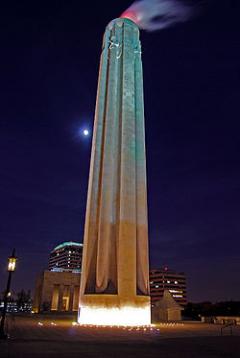
As of April 2009, Kansas City has 13 sister cities:

Other articles connected with the culture of Kansas City:
Word Count: 9386





